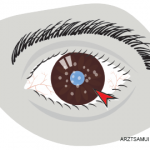NEW YORK (Reuters Health)—Rituximab may calm juvenile idiopathic arthritis (JIA)-associated uveitis and especially benefit patients who haven’t responded to other biologic treatments, a study from Italy suggests.
With its convenient dosing schedule, rituximab may be a new treatment option for patients with autoimmune diseases, especially for those who have not responded to tumor necrosis factor alpha (TNF-alpha) blockers, the authors, led by Dr. Elisabetta Miserocchi of the department of ophthalmology at the University Vita-Salute in Milan wrote in an article online Sept. 22 in the British Journal of Ophthalmology.
“This is an interesting study describing the long-term experience of this group of researchers in the management of sight-threatening uveitis associated with JIA. JIA-uveitis can be a serious disease and if untreated may lead to blindness,” Dr. John V. Forrester, ophthalmologist and emeritus professor at the University of Aberdeen, Scotland, told Reuters Health by email.
“A small subset of these patients fails to respond to anti-TNFs, which is why this paper is encouraging, particularly since it has been shown that the eye inflammation can be controlled long term by repeated infusions of the alternative biologic, rituximab, at regular intervals. This new treatment seems to be quite well tolerated and has been used in other conditions relatively safely,” said Dr. Forrester, who was not involved in the study.
Dr. Miserocchi and colleagues conducted a retrospective study of the case records of 15 eyes in eight patients who had severe, long-standing JIA-associated uveitis and inadequate uveitis control by one or more biologic agents, including at least one TNF blocker and/or abatacept. The patients ranged in age from 16 to 34 years, with a mean of 22.8. Six were female, and all were Caucasian.
The mean ocular disease duration was 17.7 years; the mean follow-up time on rituximab was 44.75 months; and the mean number of rituximab infusions received was 8.75 (range 6 to 12). All patients achieved complete uveitis control, but two patients discontinued rituximab due to its inefficacy in treating arthritis.
All patients received 1,000 mg infusions of rituximab on days one and 15 and every six months thereafter to maintain long-term quiescence and avoid uveitis recurrence. To reduce the risk of infusion reactions, they also received 100 mg of intravenous methylprednisolone, oral paracetamol and antihistamines before their infusions.
The researchers assessed the patients’ clinical responses to treatment, including uveitis activity decrease, visual acuity changes, related local and systemic corticosteroid and/or immunosuppressant reduction, and adverse events.


